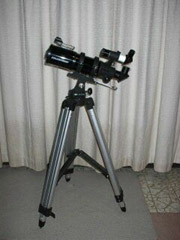Two Scopes
Compared
|
|


|
| The Celestron
FirstScope 80wa and the SkyWatcher 102 are siblings of the same line of
inexpensive refractors of Chinese manufacture. The basic layout and
general design are the same. so the modifications differ only in size -
The 102 is large enough that the FS80 could fit inside the 102's
tube! The do need a bit of improving. To see what I've
done to mine, follow the links below: |
|
|
|
|
|
|
SK102 - Objective 
The bright ring is the locking ring. You can barely see one slot
at about 5 o'clock. Be VERY CAREFUL - this is very close to the
expensive lens and coating!
FS80 Objective
The dull plastic ledge visible between the dew shield and the lens is
the locking ring. This one is easy to remove because it caps the end
of the lens assembly after you remove the dew shield.
|
Remember that these
scopes are intended for wide views and low magnification. If you
strictly stick to those views, I doubt you'll ever need to collimate
it. However, I can never leave well enough alone and some times
pushed the limits pretty hard.
Before going to the bother of collimating, check the focuser tube for a
screw that sticks up in the light path. This creates a number of
artifacts that must be cured before attempting collimation!
Collimation couldn't be more simple, but that's also the problem.
Start this when you've got loads of time! Here are the steps:
- Remove the dew shield. (It's held on with friction and
may take some effort to remove the first time. Try wiggling it
from side-to-side.)
- Find the locking ring for the objective lenses. See the
photos on the left.
- Hold the tube with the lenses up.
- Loosen the locking ring slightly
- Drum on the side of the tube to settle the lenses.
- Tighten the ring carefully. (Not too tight or you'll
stress the glass and add problems.)
- Do a quick star test.
- Repeat steps 3-7 until the scope passes the star test.
This may take a while!
- Replace the dew shield.
|
|
|
I use a precision pinhole mounted on a AAA battery maglight to form an
artificial star (purchased from ApogeeInc.com),
in this case taped to a door frame across the house. It works for
the fast scopes, but not the LX-90 - For it, I run the light down the
alley to get enough distance. Once I'm happy with the view through
the artificial star, I then do a real test.
|
 |
|
|
 |
Both scopes came with an equatorial mount,
but I don't use them. (I bought this scope before the Orion ST80 was
available as an OTA only.) I purchased an
Orion AZ-3 mount to simplify operation and setup. Both mounts needed a bit of work.
See my mounts modification page for
more info. |